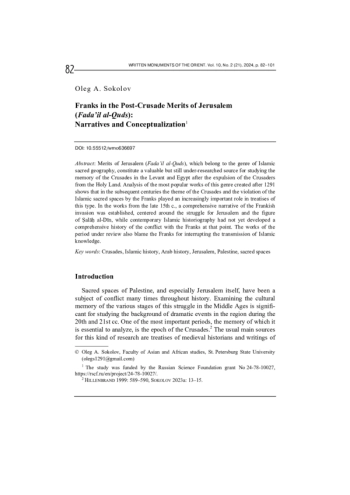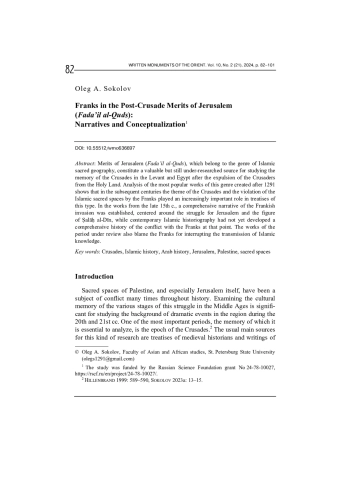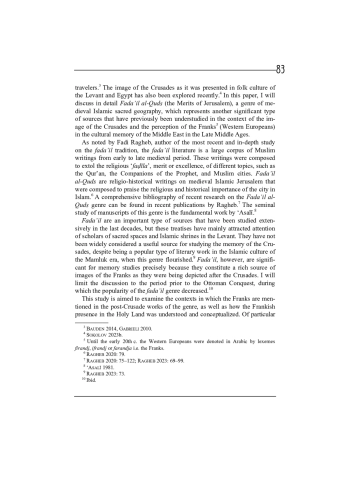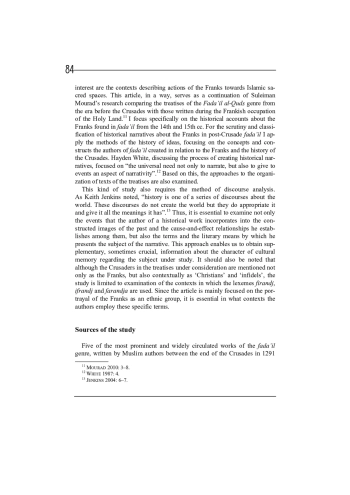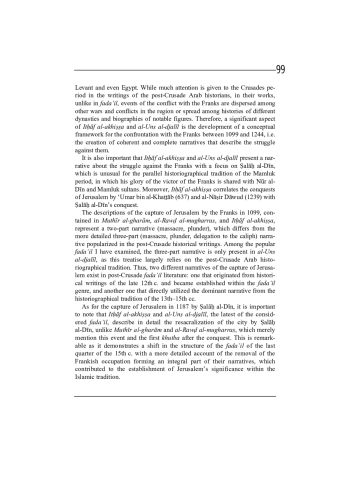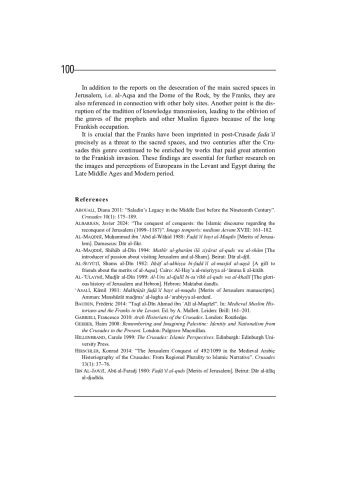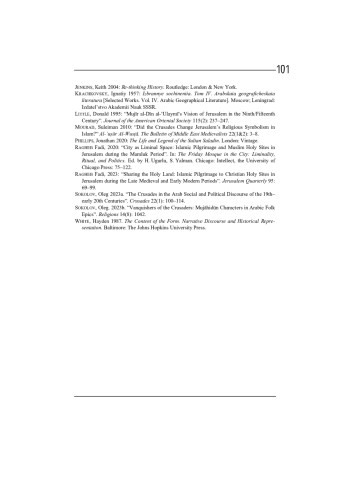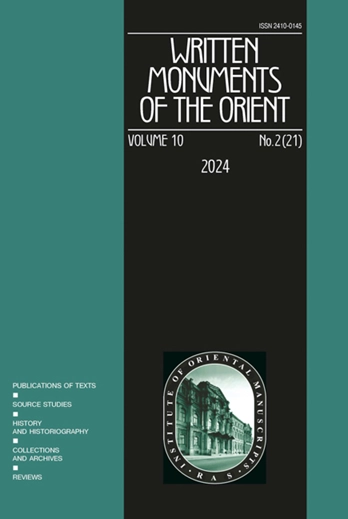Merits of Jerusalem (Fada’il al-Quds), which belong to the genre of Islamic sacred geography, constitute a valuable but still under-researched source for studying the memory of the Crusades in the Levant and Egypt after the expulsion of the Crusaders from the Holy Land. Analysis of the most popular works of this genre created after 1291 shows that in the subsequent centuries the theme of the Crusades and the violation of the Islamic sacred spaces by the Franks played an increasingly important role in treatises of this type. In the works from the late 15th c., a comprehensive narrative of the Frankish invasion was established, centered around the struggle for Jerusalem and the figure of Ṣalāḥ al-Dīn, while contemporary Islamic historiography had not yet developed a comprehensive history of the conflict with the Franks at that point. The works of the period under review also blame the Franks for interrupting the transmission of Islamic knowledge.
Идентификаторы и классификаторы
Sacred spaces of Palestine, and especially Jerusalem itself, have been a subject of conflict many times throughout history. Examining the cultural memory of the various stages of this struggle in the Middle Ages is significant for studying the background of dramatic events in the region during the 20th and 21st cc. One of the most important periods, the memory of which it is essential to analyze, is the epoch of the Crusades.2
Список литературы
1. ARIIZUMI 2003: Ariizumi, Wako 有泉和子. “Kaizoku ni sareta kaigunshikan fubosutofu to davidofu” 海賊にされた海軍士官フヴォストフとダヴィドフ [Naval officers Khvostov and Davidov who were considered pirates]. Tokyo daigaku surabu go surabu bungaku kenkyūshitsu nenpō 東京大学スラブ語スラブ文学研究室年報 [The annual report of Slavic language and literature studies] Part 2. Tokyo University.
2. CHEREVKO, Кirill Е. 1999: Zarozhdenie russko-iaponskikh otnoshenii XVII-XIX veka [The beginning of Russo-Japanese relations in the 17th-19th cc.]. Мoscow: Nauka.
3. DAVIDOV, Gavriil I. 1848: Dvukratnoe puteshestvie v Ameriku morskikh ofitserov Khvostova i Davydova, pisannoe sim poslednim [Two journeys of Russian officers Khvostov and Davidov to America, written by the latter]. St. Petersburg.
4. HIRAKAWA, Arata 平川新 2006: Rezanofu raikō shiryō ni miru chōbaku kankei to Nagasaki tsūshi レザノフ来航史料に見る朝幕関係と長崎通詞 [Imperial-shogunal relations and Nagasaki interpreters in historical documents concerning the arrival of Rezanov]. In: Kaikoku izen no nichiro kankei 開国以前の日露関係 [Japanese-Russian relations before the opening of Japan]. Northeast Asian studies Series. Vol. 7. Sendai: Tohoku University press.
5. INOBE, Shigeo 井野辺茂雄 1942: Ishin zenshi no kenkyū 維新前史の研究 [Research about History before the Meiji Restoration]. Tokyo: Chubunkan shoten.
6. KIMURA, Hiroshi 木村汎 2005: Nichirō kokkkyō kōshōshi - hoppō ryōdo henkan e no michi 日露国境交渉史-北方領土返還への道 [The history of negotiations about Russo-Japanese border - a way of restoration of the Northern Islands]. Tokyo: Kadokawa sensho.
7. LENSEN, G.A. 1959: The Russian push toward Japan: Russo-Japanese relations 1697-1875. Princeton, New Jersey: Princeton University press.
8. MATSUMOTO 2006: Matsumoto, Eiji 松本英治. “19 seiki hajime no nichiro kankei to Nagasaki oranda shōkan” 19世紀はじめの日露関係と長崎オランダ商館 [Russo-Japanese relations in the beginning of the 19th century and the Dutch trading post in Nagasaki]. Kaikoku izen no nichiro kankei 開国以前の日露関係 [Japanese-Russian relations before the opening of Japan]. Northeast Asian studies Series. Vol. 7. Sendai: Tohoku University press.
9. NAKAMURA, Zentaro 中村善太郎 1904: Chishima Karafuto shinryakishi 千島樺太侵略史 [History of invasion to the Kuril Islands and Karafuto]. Tokyo: Bunnyukan Zohan.
10. POLEVOI, Boris P. 1959: Pervootkryvateli Sakhalina [Discoverers of Sakhalin]. Iuzhno-Sakhalinsk.
11. POZDNEEV, Dmitrii M. 1909: Materialy po istorii severnoi Iaponii i eia otnoshenii k materiku Azii i Rossii [Documents on the history of northern Japan and its relations with Asian continent and Russia]. Vol. 2. Yokohama.
12. Roshia Ibun 魯西亜異聞 [Unusual Narrative about Russia].
13. SENCHENKO, Ivan A. 2006: Sakhalin i Kurily - istoriia osvoeniia i razvitiia [Sakhalin and the Kuril Islands - a history of exploration and development]. Мoscow: Moya Rossiia: Kuchkovo Pole.
14. SOKOLOV, Аleksandr P. 1852: Khvostov i Davydov. Zapiski gidrograficheskogo departamenta morskogo ministerstva [Khvostov and Davidov. Memorandums of the Hydrographic department of the Naval ministry]. Part X. St. Petersburg.
Выпуск
Другие статьи выпуска
During the archaeographical fieldwork in August 2024 in the village of Bezhta (Republic of Dagestan), the collection of the Dagestani scholar, the naib of the Caucasian Imamate Sultanmuhammad al-Bezhti, was explored, described and digitized. Sultanmuhammad al-Bezhti, also known as Sultan-dibir, was a founder of an entire dynasty of scholars and public and political figures (among them are his sons, Kebedmuhammad and Abdulmazhid). The collection consists of classical works by Arab-Muslim authors, which were available in every Dagestan private manuscript library. However, each of these manuscripts contains a lot of important and valuable information that expands our understanding of the history and culture of this region. These include numerous glosses found in the margins, between the lines, on the flyleaf, and on the first and last pages of the manuscripts. The last page of the manuscript turns into a family chronicle, which fixes important events from the lives of relatives. Most often, copiists or manuscript owners preferred to leave such notes on the colophon page.
Nikolai Fedorovich Katanov (1862–1922), a Russian scholar of Turkic origin (Khakas), was a valuable Orientalist who wrote important works in the field of Russian Oriental studies. The framework of his scientific work was formed by various fields such as linguistics, ethnography, folklore, culture, history, archaeology and museology related to various Turkic tribes and peoples living in Siberia and Central Asia at the end of the 19th century and the beginning of the 20th c. His works made a great contribution to the development of studies on the ethnography and culture of Turkic peoples in Siberia and Central Asia. Further research, study, classification, promotion and publication of the material cultural heritage consisting of unpublished archival and visual materials of Katanov, an exemplary representative of the Khakass people and Turkic-speaking peoples of Eurasia, remains important today. Currently, the personal museum funds and collections of Katanov are stored in Kazan, St. Petersburg, Abakan, Minusinsk and Askiz. In this study, a brief review and description of the Katanov’s collections, which are preserved in the Peter the Great Museum of Anthropology and Ethnography (Kunstkamera) of the Russian Academy of Sciences in St. Petersburg, but which are little known today, will be made. These collections were collected by Katanov during his scientific expeditions to Siberia and East Turkestan2 between 1889 and 1892 in the Minusinsk region, Uryanhai region and East Turkestan. These collections, exhibited at the Kunstkamera, are published for the first time. In the future, an overview and catalog of N. F. Katanov’s Buddhist museum collections (sculpture, painting and ritual objects) will be presented at the National Museum of the Republic of Tatarstan, the State Museum of Fine Arts of the Republic of Tatarstan and the Ethnographic Museum of Kazan Federal University.
Armenian polemical literature with Muslims from the early modern Ottoman context is very scarce. Unlike in Safavid Persia, public debates were not encouraged in the Ottoman Empire. Official polemical treatises from the Armenian milieu are lacking; little has survived in the historiographies, neo-martyrological accounts, and poetry about how Miaphysite (non-Chalcedonian) Apostolic Armenians positioned themselves within the cohabitation system of Ottoman society. Even less has survived in Armenian sources about popular Muslim religious practices. Therefore, a brief account of this matter provided by the 17th c. Armenian Constantinopolitan historiographer Eremia Kʻēōmiwrchean acquires great importance. The present article aims to explore the information provided by Eremia on popular Muslim religious practices, not only because it is a rare material preserved in the Armenian sources but, most importantly, because it reveals the topics of religious debates between Christians and Ottoman Muslims in everyday life.
This article examines the first volume of Roshia Ibun 魯西亜異聞 [Unusual Narrative about Russia], a unique handwritten manuscript which depicts the story of a Japanese guard, Torizō. He was one of four Japanese guards who spent the winter of 1806 on the Sakhalin island monitoring the situation at Kushunkotan settlement. Lieutenant Nikolai Aleksandrovich Khvostov visited this settlement during his first expedition to Sakhalin in 1806. In his logbook he gave it an interesting name “Lyubopytstvo”, which can be translated into English as “Curiosity”. Curiously enough, this was the place where Khvostov and the four Japanese guards met for the first time. It is considered to be the first military clash between the countries and a turning point of Russian-Japanese relations, since Russia subsequently began to be perceived as a dangerous enemy. The first volume of the source gives especially valuable information about these events. It provides a detailed description of the voyage of the four Japanese captives to Kamchatka on board of a Russian ship, contains important information about the events during the second expedition of Khvostov and Davidov to Sakhalin and the Kuril Islands in 1807 and relates the trip of the four Japanese guards back to Japan. The first volume of Roshia Ibun, which has never been translated into Russian nor published yet, gives us answers to the following questions. Who was the guard Torizō? How did he perceive the meeting with the Russians in 1806? Were there any official messages or demands from Russian officers? How did Torizō manage to get back to Japan and did he have a chance to share his story with anyone else along the way?
Volumes from 15 to 20 of Heishuicheng Manuscripts Collected in Russia selectively represent the Mahāprajñāpāramitā-sūtra in Tangut language held by the Institute of Oriental Manuscripts of the Russian Academy of Sciences. The fundamental edition of the Collection certainly is not free from some invalidities, which became evident with the time. For the Tangut version of Mahāprajñāpāramitā-sūtra, (1) some folios of different volumes were mistakenly spliced together; (2) the order of the folios of the same volumes were mixed up. The problem of identifying of the text was also aggravated by omissions made by the Tangut people, who copied the text of Sūtra. This paper suggests some new readings and identifications in the Tangut version of Mahāprajñāpāramitā- sūtra.
The article introduces three previously unknown fragments of 17th c. Mongolian Kanjur manuscripts. While the original folios have been lost, their texts are preserved in handwritten copies produced in the 19th c. by an unidentified German scholar. These copies became known in 2021 after being admitted to the Manuscript Department of the Library of the Russian Academy of Sciences. This article focuses on the Mongolian text of the fragments, its identification, and a brief commentary on the trustworthiness of the handwritten copies.
Статистика статьи
Статистика просмотров за 2025 год.
Издательство
- Издательство
- ИВР РАН
- Регион
- Россия, Санкт-Петербург
- Почтовый адрес
- Дворцовая наб., 18
- Юр. адрес
- Дворцовая наб., 18
- ФИО
- Попова Ирина Федоровна (Директор)
- Контактный телефон
- +781 (23) 158728_
